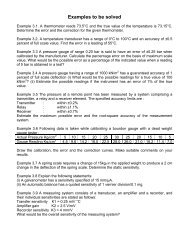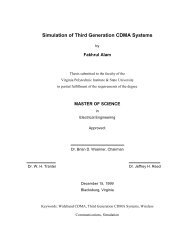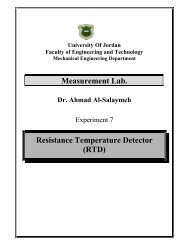Communications I Dr. Mohammed Hawa Introduction to Digital - FET
Communications I Dr. Mohammed Hawa Introduction to Digital - FET
Communications I Dr. Mohammed Hawa Introduction to Digital - FET
Create successful ePaper yourself
Turn your PDF publications into a flip-book with our unique Google optimized e-Paper software.
8. M-ary CodingAll the line coding schemes discussed above are called binary codes, since thenumber of bits per second is identical <strong>to</strong> the number of symbols per second (calledbaud rate). We say that for binary signaling:f0, data bit rate [in units of bit/s] = fsymb, symbol rate [in units of baud]Notice that a symbol is defined as a waveform pattern that the line code has for acertain period of time before switching <strong>to</strong> another waveform pattern (i.e., anothersymbol).In M-ary signaling, on the other hand, a cluster of bits is grouped <strong>to</strong> represent onesymbol. For example, in the 4-ary (also called Quaternary) case, two bits are groupedin<strong>to</strong> one symbol. The two bits can be in one of 4 possible states, which means that thesymbol can take M=4 different symbols. The following table shows a possiblemapping of two bit values <strong>to</strong> four symbols of a Quaternary signal. Thecorresponding line code for this Quaternary signal representing the bit stream1110110001001 is shown next.Bits Symbol00 -5 V01 -10 V10 5 V11 10 VM=4levelsClockData10 V1 1 1 0 1 1 0 0 0 1 0 0 15 VCode-5 V0-10 VT 0 Bit TimeT symb Symbol TimeT sSampling Time (assuming 8 bits per sample)Quaternary CodeNotice that a symbol time Tsymb is now twice the bit time T0. This means that there arehalf as much symbol transitions as there are bit transitions. We can say that:symbol rate [in units of baud] = (½) × data bit rate [in units of bit/s]For a general M-ary line coding scheme, we have:symbol rate [in units of baud] = (1/log2 (M)) × data bit rate [in units of bit/s]16
















